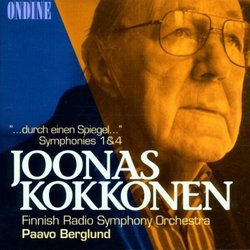| All Artists: Joonas Kokkonen, Paavo Berglund, Jouko Laivuori, Finnish Radio Symphony Orchestra Title: Joonas Kokkonen: "...durch einen Spiegel..."; Symphonies Nos. 1 & 4 Members Wishing: 0 Total Copies: 0 Label: Ondine Release Date: 1/21/1997 Genre: Classical Styles: Chamber Music, Historical Periods, Modern, 20th, & 21st Century, Symphonies Number of Discs: 1 SwapaCD Credits: 1 UPC: 761195086025 |
Search - Joonas Kokkonen, Paavo Berglund, Jouko Laivuori :: Joonas Kokkonen: "...durch einen Spiegel..."; Symphonies Nos. 1 & 4
 | Joonas Kokkonen, Paavo Berglund, Jouko Laivuori Joonas Kokkonen: "...durch einen Spiegel..."; Symphonies Nos. 1 & 4 Genre: Classical
|
Larger Image |
CD Details |
CD ReviewsIndeed, Through a Glass Darkly. Thomas F. Bertonneau | Oswego, NY United States | 10/20/2000 (5 out of 5 stars) "When serialism (what people refer to colloquially as atonal music) became orthodoxy in Western countries after World War II, the conformist pressure to adopt it grew hard to resist. But one could discern degrees of enthusiasm for the seemingly mandatory new musical language. The musical establishment in Finland offers a case in point. A composer like Einar Englund could, on the one hand, simply refuse to adopt what struck him as anti-musical; a composer like Nils-Erik Fougstedt could, on the other hand, embrace the new style as though there were none other. As ever in Scandinavia, one could also see evidence of a "third way," as in the case of the late Joonas Kokkonen (1921-1997). Kokkonen's early work (mostly chamber music) takes a strong imprint from mid-century Russians of the Soviet School, especially Shostakovich, but beginning with his "Music for String Orchestra" (1957), perhaps to clear his palette of influences, he adopted quasi-serial procedures. A few "cells" based on non-repeating intervals undergo strict development which nevertheless tends to emphasize a feeling of tonality. The First Symphony (1958) bases all its material on fairly by-the-book transmutations of a twelve-note theme, the steps of which, however, Kokkonen arranges to suggest triadic harmonies. (The model for this is Alban Berg, as in his Violin Concerto.) The Second Symphony (1960) relaxes even more, while the Third (1967) and Fourth (1968) seem actually, in their insistence on the low registers and their employment of organ-like pedal-notes, to recur to Sibelius. (This statement would probably have irked Kokkonen, but I see no way of avoiding it.) Kokkonen's climaxes tend to build seamlessly and to break forth in surges of brass-dominated chordal writing, often abruptly cut off. For coloration Kokkonen generally selects the darker hues, relieved by contrasting if brief luminous passages that could justly be described as impressionistic. "Through a Glass Darkly" ("Durch einen Spiegel...") is a chamber concerto for harspichord and strings, very much a twilight work, ultra-cool in temperament, and poignant. A true Finn, Kokkonen is reserved in utterance and controlled in his emotions. His music is rewarding (not only the symphonies but the smaller works too) and will repay the effort of investigation many times over."
|

 Track Listings (8) - Disc #1
Track Listings (8) - Disc #1